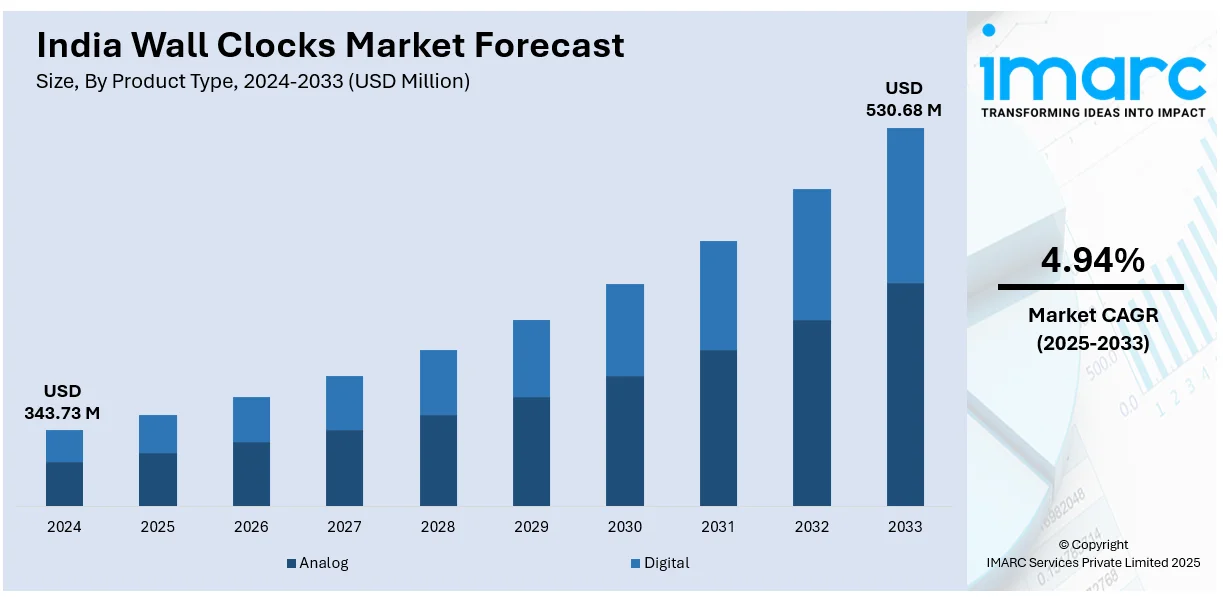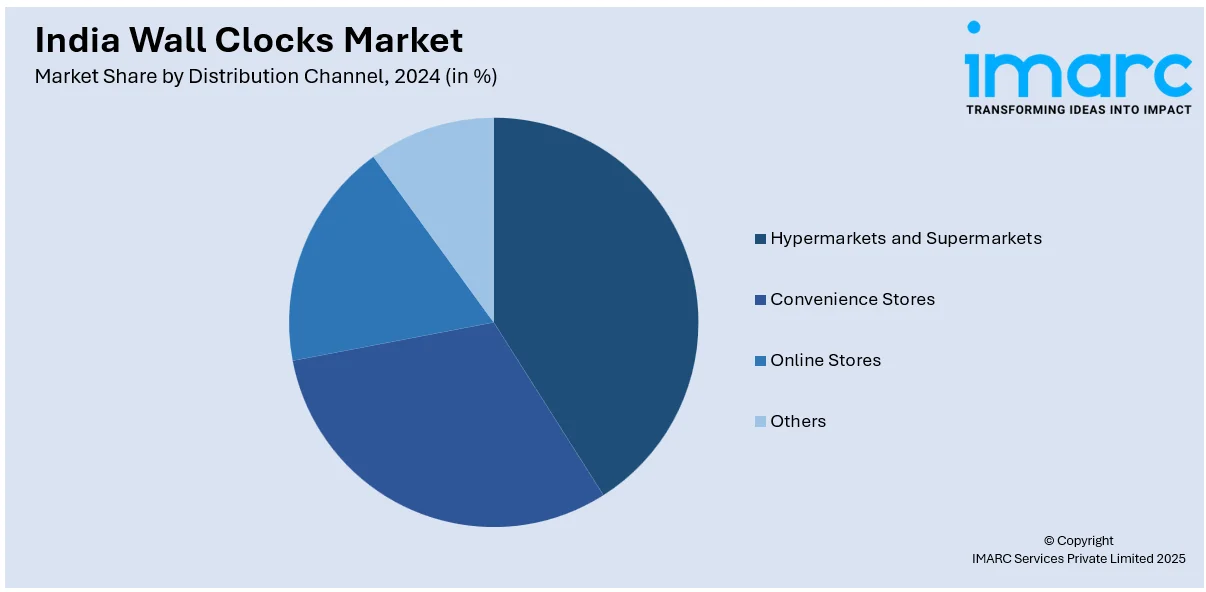
India Wall Clocks Market Size, Share, Trends and Forecast by Product Type, Frame Material, Distribution Channel, End User and Region, 2025-2033
India Wall Clocks Market Size and Share:
The India wall clocks market size reached USD 343.73 Million in 2024. Looking forward, IMARC Group expects the market to reach USD 530.68 Million by 2033, exhibiting a growth rate (CAGR) of 4.94% during 2025-2033. The India wall clock market share is propelled by the rising home décor trend, advancement in technology, such as introduction of smart clocks, increasing popularity of customized designs and shifts in consumer tastes for aesthetics and functionality.
|
Report Attribute
|
Key Statistics
|
|---|---|
|
Base Year
|
2024
|
|
Forecast Years
|
2025-2033
|
|
Historical Years
|
2019-2024
|
| Market Size in 2024 | USD 343.73 Million |
| Market Forecast in 2033 | USD 530.68 Million |
| Market Growth Rate 2025-2033 | 4.94% |
India Wall Clocks Market Trends:
Growing Demand for Smart Wall Clocks
The India wall clocks market outlook is undergoing a big change, with smart wall clocks taking their rightful place in the limelight. With the rising number of smart home device adoptions, consumers look for something new and different in these conventional products. Smart wall clocks that offer temperature control, voice assistant, Wi-Fi connectivity, and compatibility with other smart home devices are becoming a new trend. These clocks come with not just a time display but also a set of utility functions that entice the technology-savvy urban consumers. On top of that, the increase in home automation push and the growing consumer consciousness toward energy-saving and convenience have been the driving forces behind the demand for smart wall clocks. Smart wall clocks cater to contemporary lifestyles and marry style with utility. With the evolution of the Internet of Things, smart wall clocks are poised to become an avid part of home furnishings and gadgets in India.

To get more information of this market, Request Sample
Increasing Preference for Personalized and Designer Clocks
Customized designer wall clocks are in vogue nowadays in the country as people search for an unusual, elegant touch for their decor. Increasing demand has been created for personalized wall clocks thriving on uniqueness and appeal. Wall clocks are being preferred by customers, particularly in cities, according to individualistic likes, with many wanting clocks that are an extension of their home decor. Material preferences for clocks give clues to these trends, with demand focusing on clocks made from unconventional materials like wood, metal, and acrylic; intricate designs; and personalized logos and family pictures. Facilitated by online shopping portals and local artisans, users find it easy to customize their orders for wall clocks. This segment is also fast being spurred by increasing demand for luxury and high-end designer clocks. With an expanding middle-class population and rising characteristic demand for customized home décor, customized wall clocks are surely turning out as an important trend in India, thereby augmenting the India wall clocks market growth.
Increasing Popularity of Vintage and Retro Wall Clocks
In recent years, the Indian consumer has developed a penchant for vintage and retro-style wall clocks. The nostalgic look and characteristic charm that it gives the interiors attract them. The desire for vintage clocks indicates an eagerness to bridge the past with present decor. This has attracted a great following among the millennials and the Gen Z, who want to give their interiors a hint of traditional styling. Anything vintage is usually made up of brass, wood, or wrought iron; these two materials help both the aesthetic and functional aspects, thereby becoming living room, kitchen, or office space centerpieces. The emergence of online marketplaces has fueled this demand, providing easy access to numerous vintage clock designs. Retro wall clocks may become a prime market trend as more people capture the growing sense of nostalgia.
India Wall Clocks Market Segmentation:
IMARC Group provides an analysis of the key trends in each segment of the market, along with forecasts at the regional level for 2025-2033. Our report has categorized the market based on product type, frame material, distribution channel, and end user.
Product Type Insights:
- Analog
- Digital
The report has provided a detailed breakup and analysis of the market based on the product type. This includes analog, and digital.
Frame Material Insights:
- Metal
- Wooden
- Plastic
- Others
The report has provided a detailed breakup and analysis of the market based on the frame material. This includes metal, wooden, plastic, and others.
Distribution Channel Insights:

- Hypermarkets and Supermarkets
- Convenience Stores
- Online Stores
- Others
The report has provided a detailed breakup and analysis of the market based on the distribution channel. This includes hypermarkets and supermarkets, convenience stores, online stores, and others.
End User Insights:
- Households
- Commercial
The report has provided a detailed breakup and analysis of the market based on the end user. This includes households, and commercial.
Regional Insights:
- North India
- South India
- East India
- West India
The report has also provided a comprehensive analysis of all the major regional markets, which include North India, South India, East India, and West India.
Competitive Landscape:
The market research report has also provided a comprehensive analysis of the competitive landscape. Competitive analysis such as market structure, key player positioning, top winning strategies, competitive dashboard, and company evaluation quadrant has been covered in the report. Also, detailed profiles of all major companies have been provided.
India Wall Clocks Market Report Coverage:
| Report Features | Details |
|---|---|
| Base Year of the Analysis | 2024 |
| Historical Period | 2019-2024 |
| Forecast Period | 2025-2033 |
| Units | Million USD |
| Scope of the Report |
Exploration of Historical Trends and Market Outlook, Industry Catalysts and Challenges, Segment-Wise Historical and Future Market Assessment:
|
| Product Types Covered | Analog, Digital |
| Frame Materials Covered | Metal, Wooden, Plastic, Others |
| Distribution Channels Covered | Hypermarkets and Supermarkets, Convenience Stores, Online Stores, Others |
| End Users Covered | Households, Commercial |
| Regions Covered | North India, South India, East India, West India |
| Customization Scope | 10% Free Customization |
| Post-Sale Analyst Support | 10-12 Weeks |
| Delivery Format | PDF and Excel through Email (We can also provide the editable version of the report in PPT/Word format on special request) |
Key Benefits for Stakeholders:
- IMARC’s industry report offers a comprehensive quantitative analysis of various market segments, historical and current market trends, market forecasts, and dynamics of the India wall clocks market from 2019-2033.
- The research report provides the latest information on the market drivers, challenges, and opportunities in the India wall clocks market.
- Porter's five forces analysis assist stakeholders in assessing the impact of new entrants, competitive rivalry, supplier power, buyer power, and the threat of substitution. It helps stakeholders to analyze the level of competition within the India wall clocks industry and its attractiveness.
- Competitive landscape allows stakeholders to understand their competitive environment and provides an insight into the current positions of key players in the market.
Key Questions Answered in This Report
The wall clocks market in India was valued at USD 343.73 Million in 2024.
The India wall clocks market is projected to exhibit a CAGR of 4.94% during 2025-2033, reaching a value of USD 530.68 Million by 2033.
Key factors driving the India wall clocks market include increasing home décor trends, rising disposable incomes, and the expansion of organized retail and e-commerce channels. Growing consumer interest in functional yet stylish accessories, innovations in smart and designer clocks, and the rising popularity of gifting culture are further propelling market growth.
Need more help?
- Speak to our experienced analysts for insights on the current market scenarios.
- Include additional segments and countries to customize the report as per your requirement.
- Gain an unparalleled competitive advantage in your domain by understanding how to utilize the report and positively impacting your operations and revenue.
- For further assistance, please connect with our analysts.
 Request Customization
Request Customization
 Speak to an Analyst
Speak to an Analyst
 Request Brochure
Request Brochure
 Inquire Before Buying
Inquire Before Buying




.webp)




.webp)












